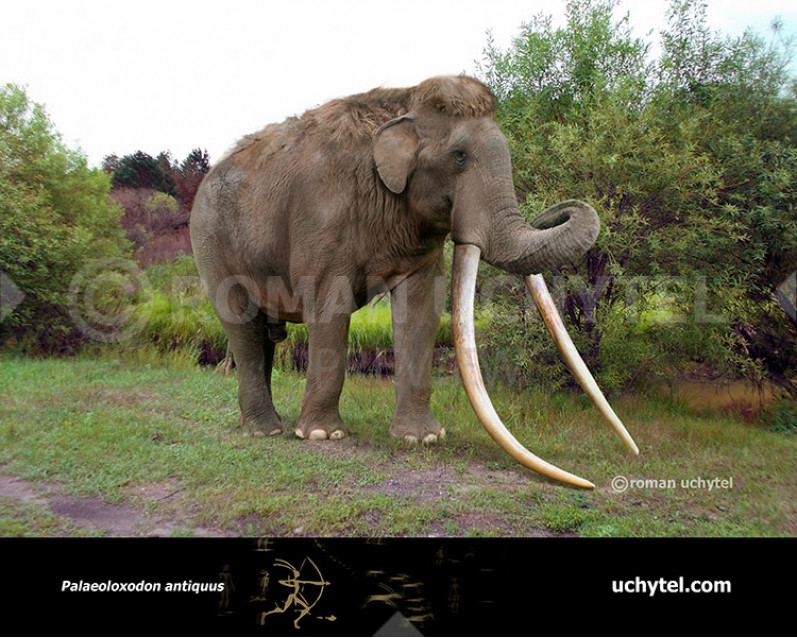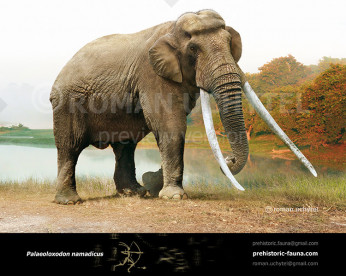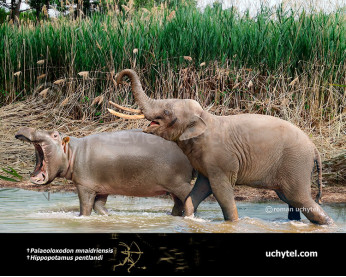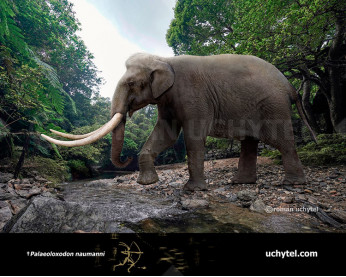Straight-tusked elephant (Palaeoloxodon antiquus)
8787Forest straight-tusked elephant (Palaeoloxodon Matsumoto, 1924)
Order: Proboscidea
Family: Elephantidae
Dimensions: length - 7m (with spiralled tusks), height - 4,3 m, weight - 10000 kg
Temporal range: during the Pleistocene epoch (Europe and Asia)
Palaeoloxodon antiquus – forest straight-tusked elephant, the largest species that survived in Europe until the end of Pleistocene.
It also lived in Asia and Africa in interglacial periods. Palaeoloxodon was a large animal exceeding mammoth in size: its shoulder height reached up to 4.3 m, and weight – up to 10 tons. Its tusks were relatively straight and often exceeded 3 m in length.
It lived in forests and sparse growths of trees feeding mostly on soft, easily digestible food like tree leaves and grass. At the times of glaciers, forest elephants lived in the south following the movement of forest zone. During interglacial periods, they migrated further north. Thus, throughout Pleistocene, Palaeoloxodon migrated and the area of its habitat changed considerably. Hunting by humans probably played the most significant role in their extinction.
Forest straight-tusked elephant (Palaeoloxodon Matsumoto, 1924)
Order: Proboscidea
Family: Elephantidae
Dimensions: length - 7m (with spiralled tusks), height - 4,3 m, weight - 10000 kg
Temporal range: during the Pleistocene epoch (Europe and Asia)
Palaeoloxodon antiquus – forest straight-tusked elephant, the largest species that survived in Europe until the end of Pleistocene.
It also lived in Asia and Africa in interglacial periods. Palaeoloxodon was a large animal exceeding mammoth in size: its shoulder height reached up to 4.3 m, and weight – up to 10 tons. Its tusks were relatively straight and often exceeded 3 m in length.
It lived in forests and sparse growths of trees feeding mostly on soft, easily digestible food like tree leaves and grass. At the times of glaciers, forest elephants lived in the south following the movement of forest zone. During interglacial periods, they migrated further north. Thus, throughout Pleistocene, Palaeoloxodon migrated and the area of its habitat changed considerably. Hunting by humans probably played the most significant role in their extinction.

-797x638.jpg)
-797x638.jpg)

-4-797x638.jpg)
-2-797x638.jpg)
-797x638.jpg)
-3-797x638.jpg)
-70x56.jpg)
-70x56.jpg)

-4-70x56.jpg)
-2-70x56.jpg)
-70x56.jpg)
-3-70x56.jpg)


-cypriotes-346x277.jpg)

